While Telltale Games, the maker of The Walking Dead series, went down in flames, the mantle for storytelling games shifted to a French studio in Paris called Dontnod Entertainment. Dontnod had a big success in 2015 with the original Life Is Strange title that blended storytelling, teen angst, and supernatural powers.
The success of that game gave Dontnod the confidence to continue with that series, and the studio debuted Episode 1 of Life Is Strange 2 in September 2018. The studio’s publisher, Square Enix, released new episodes every quarter and now the tale of Sean and his younger brother Daniel is coming to an end. Like a couple of lost wolves, the brothers hit the road the together after a tragedy forced them to flee their home. Along the way, the player assumes control of Sean and has to make decisions that will make a big impression on his younger brother. As Daniel’s supernatural powers grow, Sean has to make the right calls. And the result is a lot of drama.
I sat down with the Life Is Strange 2 leadership team as they toured Silicon Valley. Our interview group included writer Jean-Luc Cano, co-creative director Raoul Barbet, and co-creative director Michel Koch. They have finished their work on Life Is Strange 2, whose fifth and final episode debuted via publisher Square Enix on the PC and consoles earlier this month. I’m about to play the fifth episode to find out what happens with the two wayward brothers. In the meantime, we had a nice, spoiler-free chat.
Here’s an edited transcript of our interview.
June 5th: The AI Audit in NYC
Join us next week in NYC to engage with top executive leaders, delving into strategies for auditing AI models to ensure fairness, optimal performance, and ethical compliance across diverse organizations. Secure your attendance for this exclusive invite-only event.
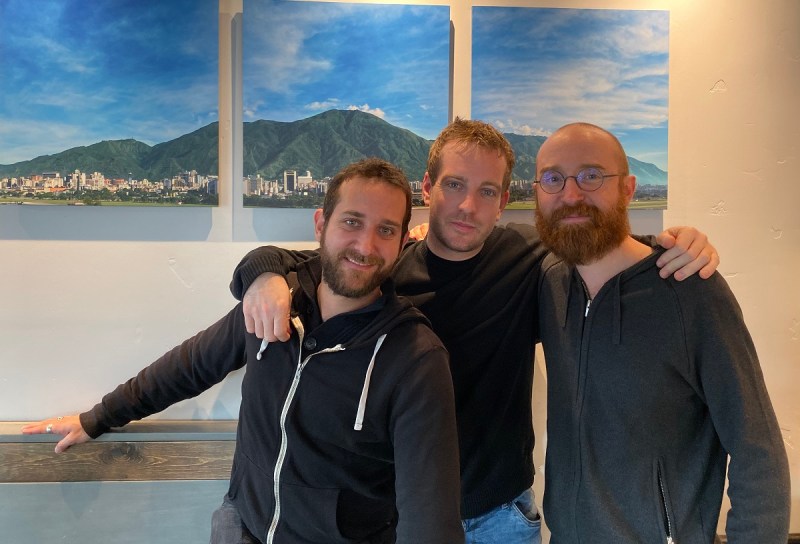
Above: Life Is Strange 2 leaders (left to right): Jean-Luc Cano, Raoul Barbet, and Michel Koch.
GamesBeat: With the last episode, I observed that there was a very directed ending to it. I didn’t have so much control over the outcome of the fight scene. I didn’t feel like I had decision-making power in that. But the thing that was interesting was that I had a lot of power over who I was going to hook up with. There’s so much choice on that front. That was interesting. There must be something deliberate about why you set it up that way. Maybe that’s a place to start?
Michel Koch: For each episode, and over the course of the game, we have to think about how many branches and how many choices and consequences we want to give the player. We have production issues and budget constraints where we can’t go everywhere right from the beginning or use too many big branches, because then you end up making a lot of different games in one game.
In episode three, you talked about the romance. It was important for us in this episode to give a lot of agency to the player about their relationship. Really, it’s the episode where Sean can be a teenager again. He’s with people who are almost his age, who are his new friends. It was interesting to decide at this point whether you want to stay closer to Daniel, or if you want to be a teenager again and explore friendship and romance with either Cassidy or Finn.
In episode four, you pointed out that it was more of a direct line, and I think you’re not wrong there. It’s a part of the story where Sean is alone now. He wants to find Daniel again. The big story has always been about education and about how your choices will affect Daniel. In episode four Daniel isn’t with you, so the player choices are more about how you react to the situation you’re facing. How do you react to Chad and Mike, the guys who attack Sean while he’s sleeping in the car? Also, what do you say in the final scene to try and get Daniel back? How do you react to Lisbeth and Nicholas?
I don’t know what ending you got in episode four. There’s still a lot of variation, but it’s based on what Daniel does. When he’s free of Lisbeth’s grasp, he can decide to forgive her or attack her, and then you have the choice to react to what he’s doing. Do you remember what he did with Lisbeth in your playthrough?
GamesBeat: He didn’t attack her, no. I definitely remember Sean’s eye getting hurt. Is that unavoidable?
Raoul Barbet: Yes. What changes a lot from the ending of episode three is which people are involved and whether they’re going to be injured or not, depending on your choices just before the scene or during the scene at the end. We have some changes there. But the scene will end with Sean being hurt every time. That’s something we wanted to have in the story.
Each time we try to — we have a main story to tell. We have some steps we always want to have. But we also try to add some variation, as much variation as possible.

Above: It’s been a long time since Sean stopped at this gas station.
GamesBeat: If you’re setting up episode five, what would you say about where this is all going now, and where it’s going to culminate?
Koch: There are multiple endings, for sure. From what we’ve read until now, the players are very happy. The ending they get means something to their journey. It’s very linked to their choices, so they’re happy with that. But you’ll see that it’s not only about your choices. It’s also about Daniel’s behavior and the choices you’ve made with Daniel. Daniel may change his mind. He may not accept your choices. You’ll see.
Jean-Luc Cano: One of the main differences between the first season and the second season — in the first season, it only depends on what you choose right there at the end. In Life is Strange 2, the last choice of the game is one that you make, the player, but it’s also dependent on choices that you’ve made from the beginning of the game. As Raoul said, it’s partly about Sean’s choices, and partly about Daniel’s choices. Because Daniel has been shaped by all of your previous choices, he’ll act differently in response to your last choice.
GamesBeat: How would you relate where you’re ending this game in comparison to where you ended the original Life is Strange? Is there something to sharly compare or contrast in how the endings turn out?
Barbet: What’s quite different in this case is that it’s not just about the immediate consequences of your choices in the scene. It’s also about really long-term consequences. After the ending of the story you’ll have some glimpses of the future of the characters and what they’re going to become. I don’t know that it gives more depth, but there’s something more than just the consequences of your immediate action. You’ll see, years after, some consequences.
Koch: In the first game it was really a coming of age story about Max. The final choice is almost a metaphor for Max accepting that at a certain point she can’t change everything. She decides that, to grow up, she has to accept that she has to make some sacrificing — either sacrificing Chloe or sacrificing Arcadia Bay. It’s more about her growing up by making this final decision.
In Life is Strange 2, the endings are about the reaction of Sean and Daniel to the world around them. What will be their place in the world, based on — well, you’ll have to see what is the final choice. But what will they become as a family, as two brothers, in our world? It’s all based on your decisions and how you educated Daniel over the course of the five episodes. I think it’s two different approaches. As Raoul said, at the end of Life is Strange 2, you see more of what’s happening to Sean and Daniel, because we want to show their relationship to the world around them.
GamesBeat: You might say that the first game had a no-win ending. Do you feel the same way about this one?
Cano: There’s no good or bad ending in the first Life is Strange, and the same is true in Life is Strange 2. There are more endings, but none of them are good endings are bad endings, a right way or a wrong way. It’s all in this gray area. In every case, it’s maybe a bittersweet ending. There’s no purely happy ending or bad ending. In every ending we’ve tried to include both good moments and bad moments, because that’s what happens in life most of the time.

Above: Life Is Strange 2 takes place on the road.
GamesBeat: How are you feeling about this whole genre of storytelling-focused games? Do you think it’s going well overall? Are players really enjoying it? People are enjoying your games, but Telltale had a lot of problems. It’s hard to tell what wrong there. It seems like there have been ups and downs for the genre.
Barbet: Like you said, with Telltale I don’t know the exact reason for what happened. There are probably a lot of different reasons. It’s not only the quality of the games. We’re happy to see that this kind of game has found a big audience, and might be reaching some people who aren’t used to playing games. The gameplay isn’t so complicated. There’s more dialogue and interaction with those choices. A lot of people can play this kind of game. We can reach a lot of people.
We love strategy games and shooters, of course, but we need to have all sorts of games. These kind of choose-your-own-adventure games, even the ones Netflix has tried to do, it’s a new type of game. Some people have said that this isn’t really a game, or there’s not enough gameplay, but I think it’s a kind of game that suits a certain type of player. You can talk about a lot of different subjects in these games, too. You might not talk about certain kinds of subject matter in a shooter, because it’s just not the right place for the topic, but in these games it’s interesting to talk about different subjects and present original characters.
We can reach more and more people. It’s just a question of taste. People enjoy the stories and characters and the style of interactivity. We can put together a good story with good characters and add interactivity — not just interactivity for its own sake, but choices and puzzles and interactivity that means something.
GamesBeat: Does Tell Me Why feel like it’s part of this journey for you, or is it something totally different?
Koch: It’s a completely different team. We’re not working on the game. The games at DONTNOD are all made by separate teams. We’ve just finished Life is Strange 2, and we’re not sure what’s in the future for the three of us, but we’re sure we want to keep working together. We’ve been working together since the first Life is Strange, and then on Captain Spirit and Life is Strange 2. We’ll see what we do in the future, but we don’t know what it will be for now.
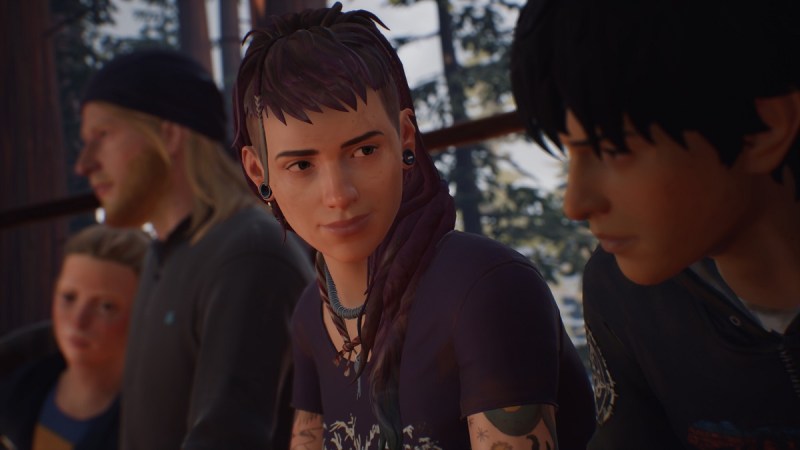
Above: Cassidy takes a look at Sean in the truck in the woods.
GamesBeat: How do you feel about where you are on the technology front, being able to visualize things the way you want it? How realistic do you think you can make your digital human characters?
Barbet: We did a lot of improvement in the second Life is Strange compared to the first game. We wanted to keep the same visual style and not have realistic humans — to have this slightly animated concept art feeling, like something that could be in a Pixar movie. Something more like a 3D animated film than a live-action movie.
I really like this kind of style, because I think it can age in a good way compared to trying to have overly realistic humans. We have limitations on the animation anyway. It works better if you have a character who’s a bit cartoonish, if the animation is not so developed. If you have a very realistic human being, the animation needs to be perfect, or you end up in the uncanny valley.
With the art style in Life is Strange, we enjoy how the player can project some of their own emotions and imagination. Not everything is shown to them clearly. It’s more about getting a feeling about the character — the environment, the lighting, the mood — rather than showing every small detail in the textures and everything.
There are a lot of improvements we can still make in future projects, though. We can improve the character animation, the close-in movements. We can use a lot of different technology even if we’re not going toward a fully realistic game. There’s still a lot of improvement to be done with this stylized rendering.
GamesBeat: This is more speculation here, but how do you think you could introduce more advanced AI into what you do? Could you have an emergent character that could respond to your story?
Koch: There was a small text-based RPG released a few days ago, AI Dungeon 2, where they use AI to generate what the dungeon master is telling you. I’ve seen people posting screenshots of their games, and it’s crazy. It’s generating tons and tons of realistic setting. You type whatever you want and the game tries to adapt the story to respond to what you’re doing.
Who knows? It’s really interesting technology. I don’t know if it’s something we need to look at, but we’ve seen what can be done with faces with different apps, things like replacing the faces in videos. There might be a way to use things like that to generate pieces of a story.
Cano: Maybe in an open world, like Red Dead Redemption, you could generate side quests at will. You’d have new quests again and again based on adapting the characters to each new procedurally generated script. That could be fun.
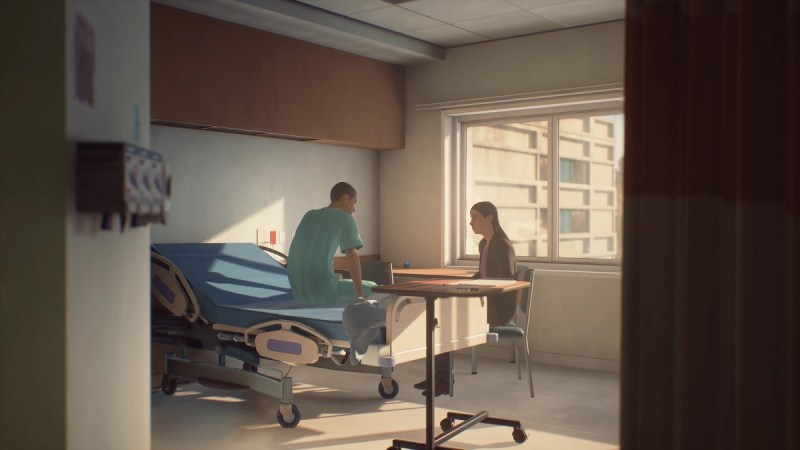
Above: Sean in the hospital.
GamesBeat: But for you guys right now, you have to have hard-coded options. You choose this, this, and this.
Barbet: In our case, except for Daniel — he has a bit of AI, a very simple one, where he has actions he can do, and reactions to your actions….
Koch: It’s basically a scripted AI. We program a lot of possibilities and then it reacts to what you do, choosing the right actions based on what Sean is doing. It’s like a companion AI in the classic sense. But it’s still very challenging and interesting work to on, because we wanted Daniel to behave like a kid. We didn’t want him to just sit around and do nothing. We wanted to try to see how a kid would act and give that quality to Daniel. If you wait too long, he’ll start to fidget, scratch his hips, look at something. If you move and look at something, he’ll follow you and look at it too and make comments. That’s the kind of thing we worked on for Daniel.
GamesBeat: I remember the flowchart from Detroit: Become Human. That seemed like an awful lot of branches. I was looking at some of them and realizing that there were long branches that I’d never played.
Barbet: It’s a question you have to ask yourself as a writer or a designer. You have a certain amount of money to create a game, so do you want to create a whole branch of the game that maybe 10 percent of the players will see? It’ll cost a lot. You have to make the right choices to be sure that if you create a scene or a character — we want to fit as much as we can given our production constraints. It’s not the same as a Quantic Dream game, of course.
GamesBeat: Does the episodic nature of your development help you there? You have smaller pieces to work on at any given time.
Koch. Right. We can also add some options from one episode to another. Maybe we’ll add something based on feedback from a previous episode. That’s been very good.
GamesBeat: Did you have any of that in episode five? Was a lot of that based on the way people had played episode four?
Barbet: We couldn’t make changes from episode four to episode five, because when episode was released, episode five was already well advanced. I don’t think we changed almost anything as far as the central story, but there are still some ways to slightly adjust things. The episodic development also lets us adjust based on how the project goes. There were some scenes we had planned for episodes four or five that we reduced a bit to make sure we stayed in our production constraints.
GamesBeat: Are you up for one of the Game Awards?
Cano: Yeah, we’re nominated in Games for Impact. It depends on the public vote.
Koch: It’ll be cool to go to the ceremony and see all the other awards, and maybe some new announcements.
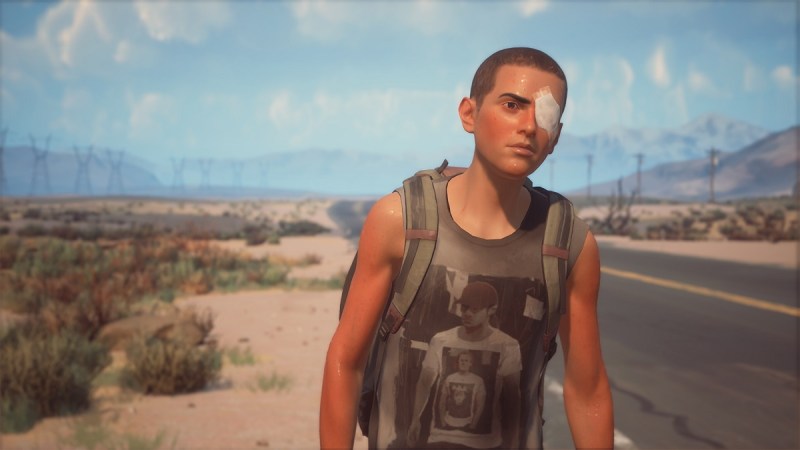
Above: Sean isn’t the same person he once was.
GamesBeat: If you think about what’s come before — if you’re thinking about another installment of Life is Strange, what kind of game is that? What kind of story do you think you would tell given what you’ve done with the first two games? What would you say is common among the Life is Strange games?
Koch: That’s a question we asked ourselves when we started work on the second game. The first game was a story we wanted to tell, and we had the chance to find Square Enix as a publisher, but we were never sure if it could be more than that. It was the story of Max and Chloe. We knew that we had another story we wanted to tell, but it was definitely not a direct follow-up to their story.
When Square Enix asked us to work on Life is Strange 2, we talked with them about it, and we all agreed that the series would be more of an anthology, with different storylines. We felt that what was most important would be to talk about relatable characters who are living in real-life situations and facing real-life issues, but with just a hint of a supernatural element to help us reinforce the main themes of the story.
I’d guess that other games would also start from scratch to find new characters and new stories with some kind of supernatural element that would make it interesting for us. But it would still take place in the same universe. There could be some links between the games. You saw in the first episode of Life is Strange 2 that there’s a small link with season one. You might see a few more links in the final episode. There’s still a way to blend some of the characters, but we want to tell different stories, approach new themes, and be fresh. We don’t want to just tell the same story with the same characters every time.
GamesBeat: I played Man of Medan and liked that. Their anthology approach seems like it’s going to give you a mix of horror and the butterfly effect, where lots of little decisions end up being life or death decisions and you don’t know it. I’m not sure if I liked that so much compared to making a very important, deliberate decision, which seems like it’s more what you’re doing.,
Barbet: It’s a bit different, yeah. I haven’t played Medan, but I played the one before, and that was a lot of fun. It’s using the classic horror movie ideas — the slasher, the monster, trying to save everyone. It’s quite different from a writing point of view, even though the mechanics are similar. You can’t see the consequences coming.
GamesBeat: It’s fun to have some illusion of emergence and unpredictable surprises coming up. But losing your character because you turned left instead of right….
Koch: You had that in the old choose-your-own-adventure books. You see two doors, you open the left door or the right one, and through the left door there’s a pit of spikes that kills you. It’s why you’d always have your finger on the page where you started.
We used a bit of that in the first Life is Strange because we had the rewind feature. There were scenes we designed with that in mind. It was mostly the scene with Frank in episode four, where it was hard for the player to predict. But since we had the rewind, we wanted it to almost be like that choose-your-own-adventure book, where you just make a choice and Frank kills Chloe or the dog attacks Max and then you rewind. We deliberately did that in those scenes because we had the rewind power. It was a way to experiment with that. But in a game like Life is Strange 2, a longer game with no rewind, we prefer to have choices that are less random and more something where you can shape the story and characters based on your choice, instead of having these harsh consequences that come out of nowhere.
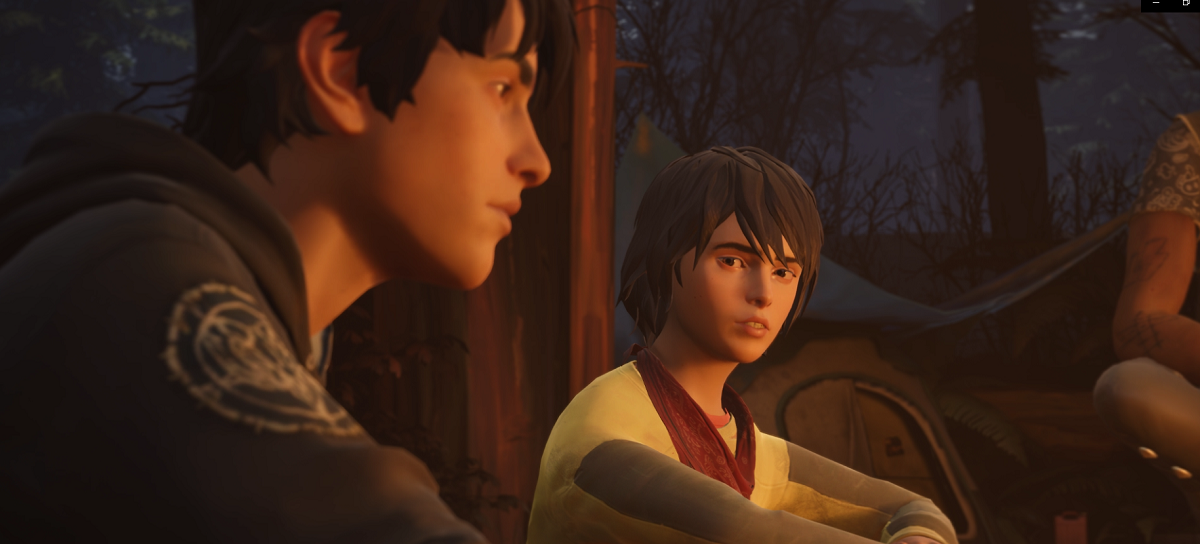
Above: Sean, left, is responsible for Daniel in Life is Strange 2.
GamesBeat: What does it feel like the impact has been for this game, given that you’re up for the Games for Impact award?
Koch: Well, we don’t have an acceptance speech yet. We need to work on that. I think we can look at the messages we’ve received from the players to understand the effect of our game. When you’re creating a game, of course you have an idea of what you want to tell, but you’re never sure if that will reach your players.
Looking at the reception for the game, we’ve gotten a lot of thanks from players who said they were happy to see some of their issues, some of the things they face in real life, portrayed in the game. Some of our players don’t experience, for example, the racism that Sean and Daniel face. Some players have said it’s helped them to open their eyes. I don’t know if this is the right word, but some players have said it’s helped them be more empathic with the people around them, to sometimes take more care with the people they meet.
That’s the kind of thing we wanted to talk about in this game — to talk about people living differently, living on the outskirts of society. We wanted players to meet them and talk with them and maybe see them with a different eye.
GamesBeat: How many consequential decisions do you think I’ll have to make in episode five?
Koch: Wow. We don’t really count those up?
Barbet: As far as all the choices that are taken into account at the ending, I think it’s hundreds, over the course of the whole journey.
Koch: Episode five is the end of the journey, where we’re putting more importance on how Daniel will react differently based on what you did in the earlier episodes. It’s the end, so a lot of events have already been shaped. We don’t want to have too many new choices, but there are still some smaller decisions you can make with Sean. You can still change a few things. There will be some tough ones, some interesting ones you can make to finish story arcs with the secondary characters.


